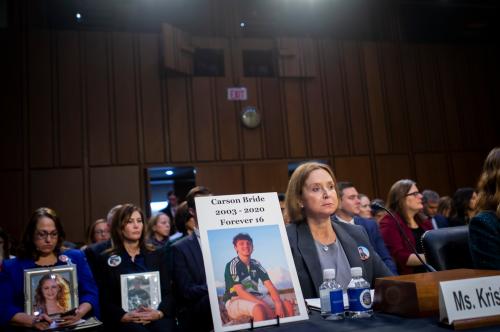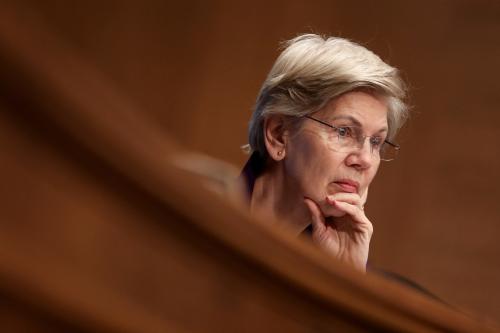In November 2021, when Congress approved $65 billion for the expansion of high-speed broadband networks as part of the Infrastructure Investment and Jobs Act (IIJA), it tasked the Federal Communications Commission (FCC) to “take steps to ensure that all people of the United States benefit from equal access to broadband internet access within the service area of a provider of such service.” In the statute, the term “equal access” refers to “equal opportunity to subscribe to an offered service that provides comparable speeds, capacities, latency, and other quality of service metrics in a given area, for comparable terms and conditions.” These mandates can be found in Section 60506 of the IIJA, and further require the FCC to create model state and local policies to combat digital discrimination among ISPs and revise its public complaint process to usher in consumer reports related to digital discrimination.
In principle, Congress’s directive is straightforward and reasonable considering the significant federal dollars being doled out to internet service providers (ISPs) for expanded high-speed broadband deployments. Moreover, the statement of the policy to avert digital discrimination attempts to guarantee that all communities, regardless of income level, race, ethnicity, color, religion, or national origin, will have available and affordable broadband internet access when the federal grant expires.
Regardless of its intent, commenters on opposite sides of the issue agree that the provision is vague. The ambiguous nature of the provision—and the question of what, exactly, digital discrimination means—has created room for a heated debate between public interest groups, ISPs, industry associations, and think tanks. With a November 15 deadline looming to deliver definitional language and guidance to Congress, the FCC must decide on their definition, approach, and methodologies for finalizing rules for digital discrimination, and choose between the adoption of either differential treatment, disparate impact, or another standard when identifying and investigating potential claims or complaints by subscribers that come from federally protected groups, and communities with certain economic vulnerabilities.
However, as is the case with most technology policies, the details matter and will determine the long-term success of this initiative, particularly in how the FCC identifies and mitigates complaints of digital discrimination. And the question of who is directly affected by any new rules and policies is critical. Section 60506 makes clear that any model policies are to be applied to ISPs, but the FCC is actively seeking comment on whether its rules should be limited to ISPs or cover all those involved in providing or determining access to broadband, including state and local governments, those who maintain network infrastructure, and landlords, in instances when the existing policies of these actors contribute to or maintain structural discrimination.
Since fall 2021, the FCC has been diligently working on this assignment, beginning with Chair Jessica Rosenworcel advising her newly rechartered Communications Equity and Diversity Council (CEDC) to focus on the creation of model policies and practices for states and localities to combat digital discrimination. At the time, Dr. Turner Lee, one of the co-authors of this blog, was appointed as Vice Chair of the CEDC, and worked closely with other members from industry, academia, civil society organizations, and other think tanks to opine on the recommendations that were voted on and accepted by the FCC in November 2022.
In late December 2022, the CEDC recommendations were integrated into the FCC’s formal Notice of Proposed Rulemaking (NPRM), which outlined preliminary questions for defining digital discrimination for public comments and requested input on directions that the FCC could take, including a clear and executable definition of “digital discrimination of access.” In particular, the NPRM solicited input around an extensive range of areas in accordance with Section 605606. Largely, the agency requested comments around what rules the agency should adopt to facilitate equal access and prevent digital discrimination. The NPRM also inquired about other steps that the agency should take to eliminate digital discrimination, and what data (internal and external to the agency) should be required to consider the issue. The FCC also sought feedback on how to revise its public complaint process to gather feedback on claims of digital discrimination. These and more complex questions around how the agency should delineate intentional conduct versus disparate impact, develop model policies and practices for states and localities when working with ISPs, and determine the scope of covered entities and scenarios were included in the NPRM.
The NPRM’s inquiries on the framework to be adopted for proving discriminatory intent were prominently featured. Through a series of questions, the NPRM sought comment on whether the FCC should adopt a broad ban on digital discrimination and/or employ an existing framework on disparate treatment like McDonnell Douglas burden-shifting, which takes the name from McDonnell Douglas Corp. V. Green, 411 U.S. (1973), a defining employment discrimination case that applied Title VII of the Civil Rights Act of 1964. In this case, the Court ruled that once the plaintiff had proved their membership in a protected class, the respondent—in this case, the employer—had the burden of providing evidence of a legitimate and non-discriminatory reason for the employment outcome. While the FCC solicited comments on the applicability of such a framework to substantiate digital discrimination, it also inquired in the NPRM about other analytic models. In August 2023, Senator Ben Ray Luján and other Democrats proposed in a letter that the FCC adopt a “disparate impact analysis,” or discriminatory effects standard like the one referenced in Title VI of the Civil Rights Act to identify a policy or practice that initiates or contributes to the harm. The disparate impact regulations as described by the U.S. Department of Justice ensure “that public funds, to which taxpayers of all races contribute, not be spent in any fashion which encourages, entrenches, subsidizes, or results in racial discrimination.”
Further, the NPRM requested feedback on ways to develop a more structured complaint process for individuals with claims against ISPs, including whether broadband service providers should be subjected to formal obligations, including auditing and reporting requirements, transparency rules, among other things covered in the December 2022 NPRM. The initial and reply comment phases formally closed in April 2023.
Prior to the December NPRM’s release, Chair Rosenworcel had also established a cross-agency Task Force to Prevent Digital Discrimination in February 2022. Under the co-leadership of longtime agency professionals, D’wana Terry and Sanford Williams, the Task Force has been hosting various public meetings since February in locations across the U.S. to raise awareness about the agency’s work in the area and gather feedback from existing and potential subscribers.
A large part of the FCC’s activities revolves around developing a clear and supportable definition of digital discrimination. The most critical question is whether the agency should define digital discrimination based on a standard of “disparate impact” or “disparate treatment.” A critical distinction made in the NPRM includes two possible definitions for digital discrimination: “[p]olicies or practices, not justified by genuine issues of technical or economic feasibility,” that either (1) “differentially impact” or (2) “…are intended to differentially impact consumers’ access to broadband internet access service based on their income level, race, ethnicity, color, religion, or national origin.” The nuanced distinction between these statements is the inclusion or omission of the phrase “are intended to”—its omission could significantly expand the FCC’s ability to address digital discrimination.
The public comments submitted in response to the December NPRM reveal many different viewpoints on how the agency could proceed with defining digital discrimination and other matters. Telecommunications industry groups mostly argue that the focus should be on intentional discrimination or a disparate treatment standard. Public interest organizations, on the other hand, support the use of a disparate impact standard that averts adverse outcomes for impacted broadband subscribers. The latter standard of disparate impact, which Democrats like Luján and many public interest organizations prefer, would encompass all policies and practices that generate a discriminatory effect (individually and collectively) and that are “not justified by genuine issues of technical or economic feasibility,” regardless of whether discriminatory intent can be proved. In this latter approach, differences in pricing, competition, and quality of services could be seen as cumulative indicators for disparate impact and outcomes for more vulnerable populations.
Further, some commenters took issue with the statute’s use of the words “technically and economically feasible” when it comes to assessing the circumstances for universal broadband deployment. Among some comments from industry, the hope is that the FCC will consider the entirety of their broadband investments and the extent to which some deployments are financially or technically impractical. In a written comment to the FCC, Verizon argued that the phrase “based on” requires discrimination to be a result of decisions made directly and explicitly because of a demographic characteristic, and Randolph May and Seth Cooper of the Free State Foundation argued in a recent op-ed that the FCC’s requirement that “’feasibility’” in determining discrimination “is inconsistent with disparate impact liability’s sole concern with raw outcomes.” To be clear, the FCC has already included an explicit exception for “genuine issues of technical or economic feasibility” under a proposed disparate impact approach. If an ISP’s coverage to a given area is truly worse because the development of that infrastructure is technically or economically infeasible, it will not qualify as discrimination, but the FCC will at least be able to investigate if that is the case, which is also why some industry commenters offer the establishment of a safe-harbor policy that allows for case-by-case investigations of infeasibility claims.
It is important to highlight that these conversations are not new, and the framing of digital discrimination is an attempt to revive age-old debates around broadband competition, and universal access. In 2011, Turner Lee, et al., noted in a report that race and place were interconnected when it came to having competitive options for broadband services in case studies conducted in counties in South Carolina, Chicago, and Los Angeles as adjacent wealthier white communities had more than two providers at their disposal.
Last year, an investigation by The Markup argued that AT&T, Verizon, Earthlink, and CenturyLink “routinely offered fast base speeds at or above 200 Mbps in some neighborhoods for the same price as connections below 25 Mbps in others.” For example, in New Orleans, the study found that AT&T was 32% more likely to offer internet download speeds of less than 25 megabits per second to households in the least-white neighborhoods of the city than in the most-white neighborhoods. The Benton Institute for Broadband & Society has compiled a number of allegations: Los Angeles County’s dominant broadband provider offered slower services at higher prices with worse terms and conditions to people in higher poverty neighborhoods, and the Communications Workers of America and the National Digital Inclusion Alliance accused AT&T of prioritizing network upgrades in wealthier neighborhoods, to name a few.
But, as The Markup’s Aaron Sankin notes, there is no evidence that ISPs deliberately “partitioned cities into geographic areas based on race and used that to determine where to deploy high-speed internet infrastructure.” That is, it is highly unlikely that there exist any explicit instructions from ISP executives to deliberately offer worse deals to lower-income communities of color and poor rural areas specifically because of their race or income. Under a disparate treatment standard, this could be enough to exonerate ISPs of digital discrimination. Only through a disparate impact standard would the FCC be able to investigate whether these discriminatory effects can be justified by genuine issues of economic or technical feasibility and mitigate them if they cannot.
On the other hand, proxies of discrimination, including pricing, competition, customer service, and quality of service could establish disparate impacts without requiring proof of intent. In their filed comments, the National Digital Inclusion Alliance (NDIA) writes: “The scope of digital discrimination extends beyond bare deployment: digital discrimination also involves disparate service quality, selective network maintenance/upgrading, and other non-deployment factors.”
In the absence of a more formal record of such factors, along with lingering inconsistencies in national broadband data around deployment areas and pricing, it will be hard to substantiate the role of these other factors, either cumulatively or individually, indirectly contributing to digital discrimination. Disparate impact includes discrimination that appears more unintentional and can happen under the circumstances of policies that are facially neutral but have a disproportionate effect on certain communities. But ISPs can still argue that they had legitimate business reasons for the perceived exclusionary practices and outcomes, especially if the caveat of economic and technical reasonableness is provoked. Overall, proving discrimination under a disparate treatment standard in the current environment would be very difficult, but proving discrimination under a disparate impact standard will still require a high bar of robust data and evidence around contributing policies and practices.
Finally, the various limitations within the broad IIJA statute regarding broadband, particularly on preferred technologies like fiber optics, and the narrowly defined focus on un- and under-served communities to receive federal funds further complicate a more rigorous adoption of highly prescriptive digital discrimination rules. And there remains a possibility that the funds from the Broadband Equity, Access, and Deployment Program (BEAD) administered by the National Telecommunications and Information Administration (NTIA) at the U.S. Department of Commerce will not fully reach subscribers of color due to the lack of money going toward commercial wireless internet. According to the Pew Research Center, as of 2021, Black and Hispanic subscribers are more likely than white subscribers to be smartphone-dependent—connected to the internet only through their phone instead of a wired, home broadband connection in 2021—which may run counter to investing in the places and technologies that serve to democratize equal access. Added to this list of potential concerns is also the delayed receipt of up-to-date deployment data from ISPs that might reveal disparities in internet access.
In the background of the conversations on digital discrimination are the historic patterns and trends of larger systems of oppression that have already created disparate outcomes for certain communities. Being on the wrong side of equal access to broadband opportunities rarely is separated from the historic and persistent trends in racial segregation, particularly in areas like housing and community economic development where the federal government, states, and localities have contributed to redlining in urban and rural areas. In these and other instances, the federal government’s past (and sometimes present) elected and appointed leadership has contributed to these systemic inequalities, which now overlay the digital divide as an additional determinant to economic and social well-being.
In her forthcoming book, Digitally Invisible: How the Internet Is Creating the New Underclass (Brookings Press, 2024), Turner Lee speaks to these interconnected realities and established adverse housing policies that came out of the Great Depression. Similarly, the federal government’s use of eminent domain policies has been forced on communities to build interstate highways that contributed to racial segregation and housing/poverty redlining, which continues to persist many years later. In housing, efforts to reinvigorate the economy through the housing market after the Great Depression resulted in federal policies and programs that led to the devaluation of Black communities, the ramifications of which plague homeownership and appraisal rates, according to Brookings fellow Andre Perry. For these and other reasons, states and localities that are the prime beneficiaries of newly released broadband deployment and equity funds should not be off the hook for any final rules adopted by the FCC. Since state and local leaders will largely be directing ISPs where to focus their deployments, digital discrimination could be a product of longstanding adverse policy decisions.
Who should be covered under the new rules is a question debated throughout the Commission’s fact-finding process. Ideally, any definition should be applied to all players benefitting from federal funds and cover all those involved in providing or determining access to broadband, from state and local governments, ISPs, those who maintain local network infrastructure, and property managers and landlords who can limit broadband access.
Whatever the FCC adopts to address and redress digital discrimination will not resolve such historic and settled patterns of the segregation of individuals and communities based on federally protected characteristics, and the geographic limitations of poverty. Furthermore, the FCC should be incredibly careful not to make the existing problem worse. But all stakeholders invested in promoting universal broadband access must be held accountable in doing their part, especially in making it more equitably available everywhere and not just in priority locations for economic development.
As the deadline looms to define digital discrimination, the FCC has diligently approached the process of inquiry into the congressional mandate from the beginning, despite a trove of concerns that still need to be addressed. We see two potential paths that the FCC might consider as their deadline approaches.
A first option might be that the FCC issues a broad prohibition that leads with the values and goals of a more connected nation, explicitly calling out the barriers to deployments based on the federally protected characteristics of prioritized groups and certain communities. More like a code of conduct, the agency could use its existing authority under the Communications Act of 1934 and the Telecommunications Act of 1996—most likely, Section 706 of the Telecommunications Act—to police bad actors and use the revamped complaint center to build a substantial record of the potentially egregious behaviors that lead to digital discrimination. Here, eliminating digital discrimination can start with coordination with NTIA, which plans to receive early public comments on state digital equity plans that will be posted on the “Internet for All” website in the coming weeks. These plans will provide early glimpses into where broadband deployments and digital equity projects will be prioritized and provide a substantive way to engage equal access and opportunities.
A second path is for the FCC to tackle digital discrimination head-on with an approach that can withstand legal scrutiny at the highest level. While ISPs prefer to be subjected to rules that require a finding of intentional discrimination, public interest groups would prefer that the FCC address the realities of discriminatory effects regardless of their intent. On the latter point, any new rules would be added on to existing FCC authority and could be decided on a case-by-case basis under “the totality of circumstances”—points recently made by Public Knowledge’s Harold Feld at a public event and in the organization’s formal filing of comments. However, the challenge here is that lingering disagreements will occur between groups, along with a potentially thin record that could outlive the time allotted to deploy broadband under the IIJA.
In the end, the FCC will inevitably need to choose either disparate treatment, disparate impact, or another standard for eliminating digital discrimination. Any of these approaches will come with its own set of challenges, and substantiating allegations of digital discrimination and investigating defenses on the grounds of economic or technical infeasibility also will require robust data-gathering and a solid record of potential complaints.
Finally, the agency will also need to determine if its rules will be harmonized with other anti-discrimination laws, particularly those that have been active since the passage of the 1964 Civil Rights Act. For example, although a disparate impact standard runs the risk of a challenge in court, its use is supported by established precedent. The Supreme Court first recognized the legitimacy of the standard in Griggs v. Duke Power Co. (1971) and the Department of Housing and Urban Development uses the standard in its own antidiscrimination rules. But these laws also have an infrastructure to implement them, and at this point in their process, the FCC has its own administrative shortcomings and a lack of centralized intelligence around non-discrimination issues imposed by structural constraints. They also do not have substantial resources allocated to a dedicated team working on civil rights.
In the public comments to the NPRM, both industry leaders and public interest organizations agree that the FCC should establish an Office of Civil Rights to enable the Commission to effectively address digital discrimination. In doing so, the Commission should continue, including the CEDC, to expand its discussion on digital civil rights and equitable broadband deployments, recognizing that the scope of this issue potentially eclipses the FCC’s jurisdictional and regulatory capabilities. The current task before the FCC is to embrace a statement of policy and a clear, enforceable definition of digital discrimination to avert any possible acts of digital discrimination by ISPs, governments, and other entities receiving IIJA funds from now until the end of the program. Where the agency lands on its final report back to Congress must ensure that most communities will be served by high-speed broadband in the immediate future and not enveloped in more dogmatic policy debates around the agency’s right to do so. By establishing an Office of Civil Rights to ensure that digital discrimination rules cover any actors with power over broadband availability and by adopting an enforceable definition that addresses the realities of digital discrimination can the FCC work to ensure that broadband connections are both accessible and equitable.
-
Acknowledgements and disclosures
Verizon and AT&T are general, unrestricted donors to the Brookings Institution. The findings, interpretations, and conclusions posted in this piece are solely those of the authors and are not influenced by any donation.








Commentary
The FCC’s clock is ticking on defining digital discrimination
September 29, 2023